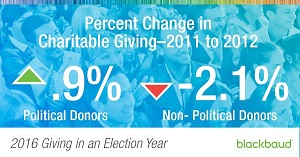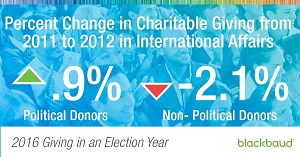 Special to the Philanthropy Journal
Special to the Philanthropy Journal
By Chris Dann
Blackbaud’s study of political and charitable giving in the 2012 presidential campaign year answered a longstanding question and suggested a new opportunity for the charitable sector: How does presidential election year campaign fundraising impact charitable giving?
While the generally held belief was that its impact is negative, Blackbaud’s study, titled “Giving in an Election Year,” showed convincingly that it is quite the opposite. The study notes that while organizations should still be wary of competing against the huge volume of political soliciting in looking for new donors, when campaigns get intense, they should not be shy about re-soliciting the donors they have – or the in the case of lapsed donors, have had. For most organizations, this finding will change their approaches to Q3 and especially Q4 planning and budgeting.
 The new opportunity suggested by the study is that political campaigns in presidential election years would seem to attract young donors in extraordinary numbers, donors who also increase their support of charitable organizations.
The new opportunity suggested by the study is that political campaigns in presidential election years would seem to attract young donors in extraordinary numbers, donors who also increase their support of charitable organizations.
We were reminded by both findings of earlier studies of major, high-profile disaster giving. Apart from such disasters, no focused event concentrates more media attention and influences greater outpouring of giving in the United States than presidential campaigns. It is the nature of a disaster coupled with its media coverage and the extent of its mortal affliction that motivates donor response. But it is the enormous investment in advertising and fundraising that accounts for the enormity of political campaign giving.
 In break-through research in 2007, Target Analytics documented an essential distinction between giving for the aid and comfort of humans and animals, and giving to organizations whose missions embrace sets of societal values that resonate with donors, such as education and cultural institutions. We found the latter retained donors much more than the former, and thereby had the opportunity to enhance their value to their organizations. We surmised that aid and comfort donors were giving through relief organizations while values donors were giving to the institutions they more readily continued to support.
In break-through research in 2007, Target Analytics documented an essential distinction between giving for the aid and comfort of humans and animals, and giving to organizations whose missions embrace sets of societal values that resonate with donors, such as education and cultural institutions. We found the latter retained donors much more than the former, and thereby had the opportunity to enhance their value to their organizations. We surmised that aid and comfort donors were giving through relief organizations while values donors were giving to the institutions they more readily continued to support.
The study of the impact of political giving affirms the power of resonance of societal values in giving. It does this in two ways, one we might have expected, and one we didn’t (and arguably couldn’t).
What we might and should have expected is the study’s persuasive documentation that people who contributed to campaigns for federal offices in 2012 contributed more to charity that year than those who did not make political contributions. This was true for giving across all the six nonprofit sub-sectors we studied, regardless of age, income, and gender. Political donors are engaged citizens, the very sort who venture their philanthropy in the hope and expectation of returns in civic and societal progress and the betterment of the  commonwealth.
commonwealth.
What we didn’t expect was the evidence that federal political campaigning and fundraising appeared to move people of an age not usually inclined to give at all to give extraordinarily to campaigns, candidates, and charities.
This was, coincidentally, the finding of the disaster donor study in 2007. A substantial plurality of the 5.6 million disaster donors we studied . In the 2007 study on disaster giving, we called these givers novice donors, donors who could not be found on the rolls of national organizations. We observe from this coincidence that the power of federal campaigning is, indeed, tantamount to the power of a high profile natural disaster in attracting novice if not new donors.
The novice political donors found in the political giving study are different than novice disaster donors in that their nascent charity with values-laden political campaigns should lead to the good prospect of their becoming donors to organizations whose missions are also values laden, whether or not they manifest in political action. In any case, the election of 2016 presents an opportunity for organizations to capitalize on the values-laden market of political and philanthropic giving.
Chris Dann is the manager of Fundraising Research and co-presenter of Blackbaud‘s “Giving in an Election Year” report. Before joining Next Generation Fundraising, he was the CEO of Drakes Bay Fundraising for 23 years. During that time he directed research, fundraising business models, and related analytical studies for most of Drakes Bay Fundraising clients. Chris’ nonprofit management experience includes having been Vice President for Development at The Nature Conservancy, Managing Director of World Wildlife Fund – US, and President of Ocean Trust Foundation. He has also served on the boards of directors of Scleroderma Research Foundation and East Bay SPCA, and serves currently on the board of Bay Nature Institute, a public media organization.




